
Our favorite packs feature straps to attach tents and other gear. Photo: Lindsey Gough//The Inertia
Backpacking is our favorite way to get out in the mountains. A good pack to haul your gear is the name of the game: Our testing team has been hard at work finding the best backpacking packs, and this list represents our favorites, from minimal, sub-two-pound ultralight options to high-capacity, stable options. Since last year, we’ve been getting out into the backcountry around North America, taking with us more than just the necessities. These backpacking packs represent the top of the top, not only for quality but for value and utility too.
Navigate To: Comparison Table | How We Tested | Buyer’s Guide
Related: Best Backpacking Tents | Best Backpacking Sleeping Bags | Other Backpacking Gear Reviews
Editor’s Note: We updated this guide in May 2025 by removing old picks, adding two new options, refreshing links, and improving navigation to other backpacking reviews.
The Best Backpacking Backpacks of 2025
Best Overall Backpacking Backpack: Osprey Atmos AG 65 / Osprey Aura AG 65
Best Budget Backpacking Backpack: REI Co-op Flash 55
Upgrade Backpacking Backpack: Osprey Aether Pro 75 / Osprey Ariel Pro 75
Runner-Up Best Backpacking Backpack: Mystery Ranch Radix 57
Best Ultralight Backpacking Backpack: ZPacks Arc Haul Ultra 60L
Best Overnight Backpacking Backpack: Gossamer Gear Skala 38
Best Overall Backpacking Backpack
Osprey Atmos AG 65 / Osprey Aura AG 65 ($340)
Weight: 4 lbs 10 oz
Capacity: 65L
Frame Type: Internal aluminum
Closure: Cinch + buckle
Available In: Men’s, Women’s
Pros: Extremely comfortable to carry, great pocket layout, well-made
Cons: Somewhat heavy, not ideal for heavy loads
Wouldn’t it be nice if you could lug all your gear miles into the wilderness and barely feel it on your back? Sure, that’s too good to be true, but the Osprey Atmos AG 65 and Aura AG 65 are seriously comfortable backpacking packs. We found the Anti-Gravity system enabled us to carry our fully-loaded packs with ease, and the plush pack straps felt secure and comfortable. Plus, these packs are full of useful features.
While it’s no secret that we love Osprey packs, we were especially stoked on the Atmos and Aura. These packs feel like the culmination of a lot of tiny tweaks and improvements by an industry giant. The pack arrangement feels super dialed: We love the sleeping bag pocket that can be individually accessed (it also fits our sleeping pad). But it’s nice that you can unbuckle the divider and use the entire capacity, too. The pack is very easy to dial-in fit, and with a few strap adjustments, you can set this up to your specific torso and waist. The Atmos/Aura is also great for cinching to your specific loadout: the compression straps, including an internal cinch, were quick and easy. That said, this pack really shines for multi-day trips. For less than a weekend, we feel like this pack is a bit overkill. The durable materials feel amazing, but they are a touch heavy (the S/M men’s Atmos AG 65 is 4 pounds 10 ounces).
Drawbacks of these Osprey packs included difficult-to-reach bottle pockets and reduced comfort when carrying heavy loads. The latter is somewhat obvious, but it is important to note that the AG setup really shines in the 25-35-pound load range, but much above that, and it starts to feel less special. All that said, carrying much more than that is going to feel pretty heavy in any pack.
Ultimately, the Osprey Atmos AG and Aura AG were our favorite backpacking packs because they balanced excellent carrying comfort with a slew of useful features. We love the sizeable sleeping bag pocket, the internal cinch cord, the front and side stretch pockets, and the zippered front pockets. Did we mention the Anti-Gravity system is comfortable? These packs ultimately took the top spot over our upgrade picks below (Aether Pro and Ariel Pro) because of the more affordable price and similar features.
Check Atmos Price on REI Check Aura Price on REI
Check Atmos Price on Backcountry Check Aura Price on Backcountry

The Osprey Atmos AG is our favorite pack this year. Photo: Nathan Lemin//The Inertia
Best Budget Backpacking Backpack
REI Co-op Flash 55 Pack ($199)
Weight: 2 lbs 13 oz
Capacity: 55L
Frame Type: Internal steel
Closure: Roll top
Available In: Men’s, Women’s
Pros: Great price, lightweight, versatile
Cons: Lacks premium features, easy to overload
The REI Co-op Flash 55 Pack unseated the Kelty Glendale below as our new favorite budget pick. But don’t get it twisted: The Flash 55 is far more than your average budget pack. This is actually one of our favorite lightweight backpacking packs in any price category. At 2 pounds 13 ounces, the Flash 55 is nestled between the more traditional (and heavier) packs and the ultralight packs. This weight savings made the Flash ideally suited to stripped-down loads, and we think it’s a perfect weekend backpacking backpack.
The Flash 55 lacks some of the structure and material thickness of traditional backpacking packs, but that’s what we love about it. Similar to the Mystery Ranch Radix, this pack cuts weight while still boasting traditional features like plenty of external pockets, standard cinch straps, and a removable lid. It may lack some of the bonus features of our top pick (like a dedicated sleeping bag pocket or a sophisticated suspension), but we found that the Flash 55 handled weekend-sized load-outs with ease. While there is plenty of space, we probably wouldn’t pack much more than three nights’ worth of gear in this, because it did feel a bit overburdened with heavy loads.
Overall, REI nailed it with the Flash 55: It’s pared down where it matters but maintains the essentials. It’s not the most comfortable carrying pack, but it’s perfect for most people who primarily get out for weekend backpacking trips. Plus, the price is tough to beat!
Check Men's Price on REI Check Women's Price on REI

The REI Co-op Flash 55 Pack was a surprise favorite: lightweight, well-featured, and stylish. Photo: Nathan Lemin//The Inertia
Upgrade Backpacking Backpack
Osprey Aether Pro 75 / Osprey Ariel Pro 75 ($400)
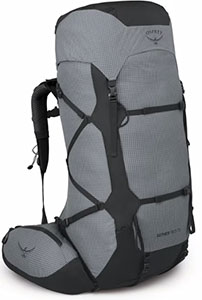 Weight: 5 lbs
Weight: 5 lbs
Capacity: 75L
Frame Type: Peripheral hoop
Closure: Roll + cinch
Available In: Men’s, Women’s
Pros: Tons of pockets, easy to customize to your liking, top-of-the-line materials
Cons: Expensive, large for shorter trips
Being the largest model on our list, we worried that the Aether Pro 75 might sacrifice too much in the weight and comfort departments. But thanks to the incredibly comfortable shoulder straps and hip belt, we found Osprey’s Aether Pro to be one of the easiest to carry the test load. Thanks to the LightWire suspension, larger loads didn’t feel much worse, and it led us to confirm what we already suspected: The designers at Osprey know a thing or two about backpacking backpacks.
With excellent padding on the shoulder and hip, we found that the extra bulk was worth it for comfort on the long haul. The hip padding is removable (along with other aspects of this pack, like the compression straps and pockets), should you prefer less weight. Add in large pockets on the hips with plenty of room to stash snacks, devices, and sunscreen, and we found ourselves taking the pack off less, resulting in a more efficient hike.
Osprey also has a huge commitment to sustainability, and all the materials in this backpack meet the Bluesign standard, so you can feel good knowing that this choice takes a lower toll on the environment. All that is well and good, but performance is still key, and we’re happy to say that this pack delivers. It’s the largest pack we recommended, and 75 liters is a lot of space. However, it’s easy to cinch this pack down smaller should you need to, and the plethora of pockets will be a bonus if/when you do need more space.
The big downside is the weight, which isn’t exactly apples to apples considering it’s the largest pack on the list. At 5 pounds, the ultralight crowd may groan after a few hundred miles. The standard Aether series (made with beefier, less premium materials) does, however, come in smaller 55L and 65L versions, if 75 liters is just too much for your needs and wants. One thing to note, too, is that the standard Aether 55L is barely lighter than the Aether Pro 75L (4.87 pounds versus 5 pounds), so we love the extra capacity and premium materials with minimal trade-off in weight. A caveat, however: This Osprey backpack is also on the pricier end of the spectrum. That said, worth the premium price point. Osprey’s top-of-the-class repair and replacement policy means that this could very well be the last pack you’ll ever need to buy.
We also tested the female version called the Ariel Pro 75, and our female tester remarked on the balanced weight thanks to the shaped shoulder straps. A few subtle differences really made all the difference for female-specific comfort, which translates into more mileage and less fatigue on the trail.
Check out our full review of the Osprey Aether Pro 75.
Check Aether Price on REI Check Ariel Price on REI
Check Aether Price on Backcountry Check Ariel Price on Backcountry
Runner-Up Best Backpacking Backpack
Mystery Ranch Radix 57 ($299)
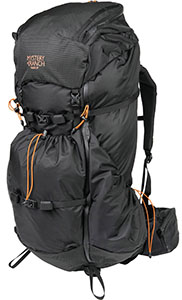 Weight: 3 lbs 13 oz
Weight: 3 lbs 13 oz
Capacity: 57L
Frame Type: Aluminum
Closure: Cinch top
Available In: Men’s, Women’s
Pros: Great middle ground between lightweight and feature-rich
Cons: Fewer premium materials than the top pick, lacks a quick stash pocket
Mystery Ranch is a backpack company, first and foremost. Its packs are well-loved by professionals who need to perform under challenging conditions, such as firefighters and medics. Mystery Ranch’s latest backpack for backpacking, the Radix series, offers a multitude of customization options to really dial in the backpacking experience to your liking.
To make the best backpacking backpacks, companies must balance weight with relevant features, such as multiple compartments, easy access, and a balanced weight distribution. This pack succeeded in all these categories, and the added customization options are a huge boon, demonstrating Mystery Ranch’s expertise in the world of backpacks.
Conveniently, the frame and the waist belt are removable in case you want to cut down the 3-pound 13-ounce overall weight and go more minimalist. The pack as a whole is fairly pared down, enabling quick access to essentials on the outside pockets while holding 57 liters inside, a great all-around size for most multi-day adventures.
The main pocket zips fully down on the side for full access to your gear in a hurry. This speeds up camp setup, just in case the weather turns. Plus, we love the fact that the Radix pack is made from recycled materials and carries a lifetime warranty; we feel great about recommending a backpack from a company doing its part to keep more waste out of landfills. Some extra options, such as stash pockets on the exterior, would have been handy, but the lightweight configuration balanced this downside. Overall, we felt that Mystery Ranch has a top-tier option with the Radix 57L.
Check out our full review of the Mystery Ranch Radix 57.
Check Men's Price on REI Check Women's Price on REI
Check Men's Price on Backcountry Check Women's Price on Backcountry
Best Ultralight Backpacking Backpack
ZPacks Arc Haul Ultra 60L ($399)
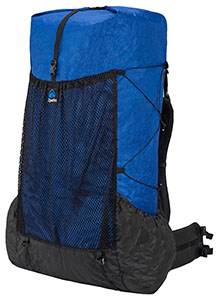 Weight: 1 lb 6 oz
Weight: 1 lb 6 oz
Capacity: 47L inside, 8L center, 2.5L sides
Frame Type: Tension straps, carbon stays
Closure: Roll-top
Available In: Unisex
Pros: Well-balanced, surprisingly comfortable backpack
Cons: Can’t separate items inside
For the lightest pack we tested, the Arc Haul Ultra has plenty going for it. It doesn’t have the multitude of features and pocket options that you get with other packs, but ultralight hikers will appreciate the attention to lightweight design over all else. However, just because it’s a slimmed-down design doesn’t mean you have to sacrifice comfort on this pack. The use of straps for airflow and support is a winner in the comfort department. ZPacks also offers a ton of add-on options to customize the pack even more, so if you want to add a few ounces and get a few extra pockets, that’s a definite possibility.
The daisy chain gear loops on the shoulder straps add even more opportunity for some nice-to-haves within reach, such as a multitool or a camera on a clip. For the fact that this is an ultralight pack, we appreciate how much thought went into the design and found that every cubic inch was usable. As with any ultralight backpacking backpack, this ZPacks option still left us wanting certain features, like a separate internal pocket for wet/dry storage or quick access to small items without having them packed away. That said, ultralight packs are just that for a reason, and most people know what they are getting with this class of pack. Of any ultralight option, the ZPacks Arc Haul Ultra backpack is our favorite.
Best Overnight Backpacking Backpack
Gossamer Gear Skala 38 ($225)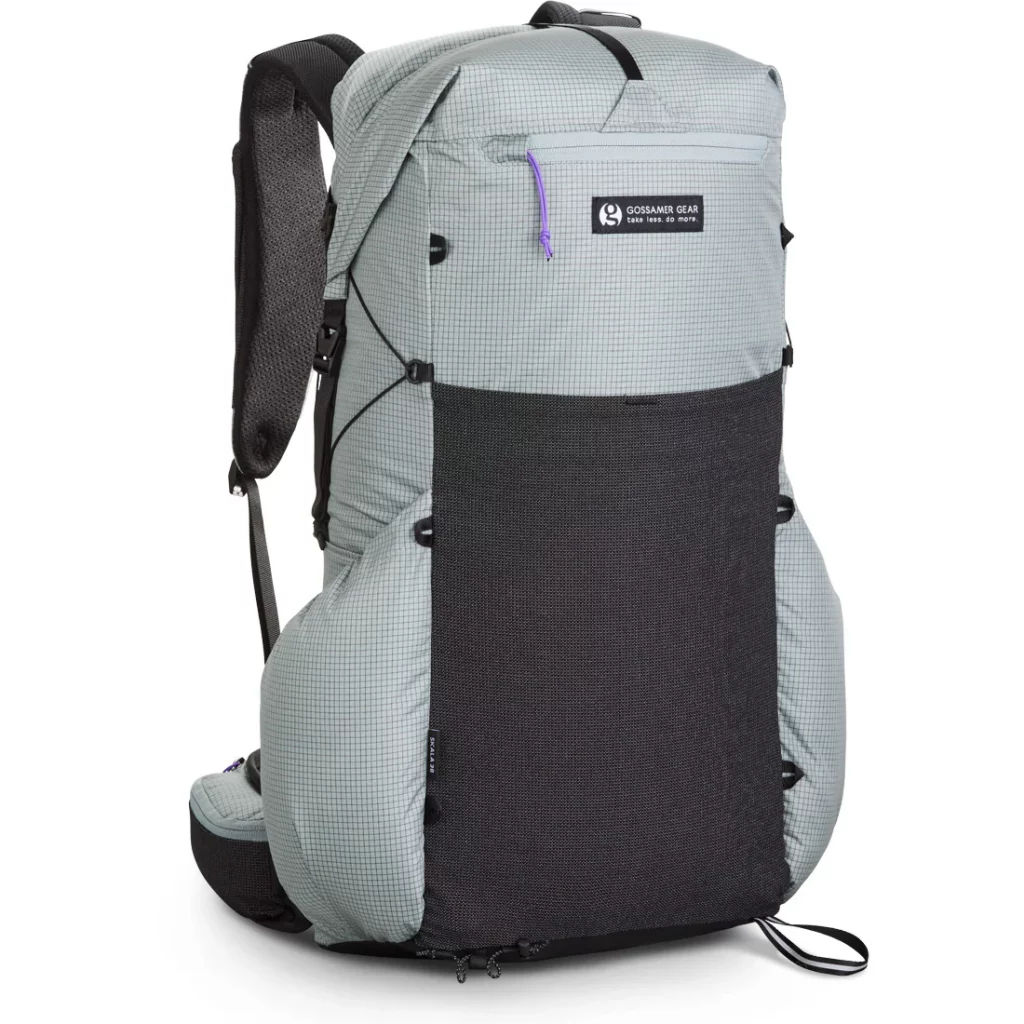
Weight: 1 lb 4.4 oz
Capacity: 38L
Frame Type: Frameless (structured back)
Closure: Roll-top
Available In: One size
Pros: Well-featured for the UL category, can reduce pack weight to under a pound
Cons: Limited sizing won’t work for all
For quick jaunts where you need enough space for the eventual but don’t want the extra weight and structure of a traditional pack, the Gossamer Gear Skala 38 is a sweet choice. Positioned right between ultralight packs and fastpacks (even lighter), the Skala 38 is an approachable option for serious UL fans who don’t want to lose every feature. Perhaps the best part of this pack is that you can scale it up or down based on need and preference. Don’t need a waist belt? Shed it easily. Don’t need the sit pad in the pack’s back panel? Drop it. Losing both brings this pack down to 14.5 ounces. Best of all, this UL pack doesn’t break the bank like some others in this list.
We found the Skala 38 impressively comfortable, even when fairly loaded down. We aren’t UL diehards, so we wore the pack with waistbelt and sit pad included, and both do help keep your load secured and centered on the back. One drawback of this option is that there’s only one size, but it’s pretty easy to dial in fit, especially because it is frameless. The big side and front pockets are perfect for quick-stash items like bottles and rain jackets, and the whole thing can be compressed with the rolltop. We loved it for overnight trips, but would certainly bring it for lighter loadouts on longer trips.
Check Price on Gossamer GearMore Top-Rated Backpacking Packs
The above represents our top picks for backpacking backpacks, but there are so many more awesome options out there. Here are a few that came so close to cracking our top picks.
Highly Durable Backpacking Backpack
Fjallraven Kajka 65 ($375)
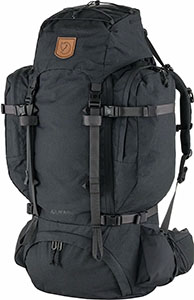 Weight: 6 lbs 15 oz
Weight: 6 lbs 15 oz
Capacity: 65L
Frame Type: Wood
Closure: Cinch top
Available In: Unisex
Pros: Impeccable quality, designed with sustainability top-of-mind, heritage styling
Cons: Heavy, somewhat overladen with straps
There’s no denying it, and it’s worth noting right off the bat: The Fjallraven Kajka 65 backpack is heavy. The heaviest on the list, it’s also the one we’d choose to have for extended trips where the pack will be taking abuse from the elements and the body. In the unlikely event of an apocalypse, this is the pack we’d choose to try to survive with. Basically, this backpack is made to last: Sustainability and longevity are crafted into the Kajka’s DNA.
If you’re okay with a few extra pounds on your back, having the Kajka 65 means a pack that will hold up when necessary. On top of that, it’s designed with great pocket placement on both sides for extra organization, as well as a bottom zip compartment that can either be separated or combined with the main pocket. That’s nothing revolutionary in itself, but on longer trips, separate compartments help keep gear tidy. Plus, we enjoy how durable the pack is in tough situations while hacking through thick alder patches and sticky underbrush in the second-growth forests of British Columbia.
Aside from the durability, we also love how the top compartment can be worn as a chest pack for easy access to a camera or snacks, without having to slow down and take the whole pack off one’s shoulders. This backpacking backpack — like much of Fjallraven’s gear — is a beautiful, well-made (albeit heavy) piece that should last generations.
Runner-Up Best Ultralight Backpacking Backpack
Outdoor Vitals CS40 Ultra ($375)
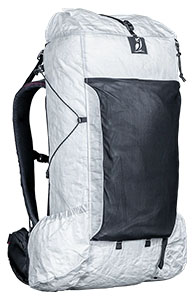 Weight: 1 lb 11 oz
Weight: 1 lb 11 oz
Capacity: 53L + large mesh pocket
Frame Type: Carbon fiber stays
Closure: Roll-top
Available In: Unisex
Pros: Material is softer than other ultralight packs
Cons: No bottom straps
Outdoor Vitals is a newer company that has made a big splash in the ultralight scene thanks to its commitment to quality, no matter what. They recently discontinued their sleeping pads because they realized they just didn’t hold up to other ultralight pads, which we found quite admirable. But their CS40 Ultra backpack is going strong and for good reason: It holds a ton of stuff, it’s strong and supportive, and it’s remarkably comfortable given the ultralight construction. The back padding was some of the most robust we found in the ultralight category, and the material felt broken in as soon as we got it, giving a much softer feel than other ultralight backpacks we tested.
If it had some straps for the bottom to fit a tent, etc, we’d be a lot more stoked. It was also about five ounces heavier than our top ultralight pick. Still, the amount that you can put in this pack is significant, and the comfort and ease of use make it a great option for those who need to shed valuable ounces.
Runner-Up Best Budget Backpacking Backpack
Gregory Paragon 50 Pack ($240) / Gregory Maven 48 Pack ($240)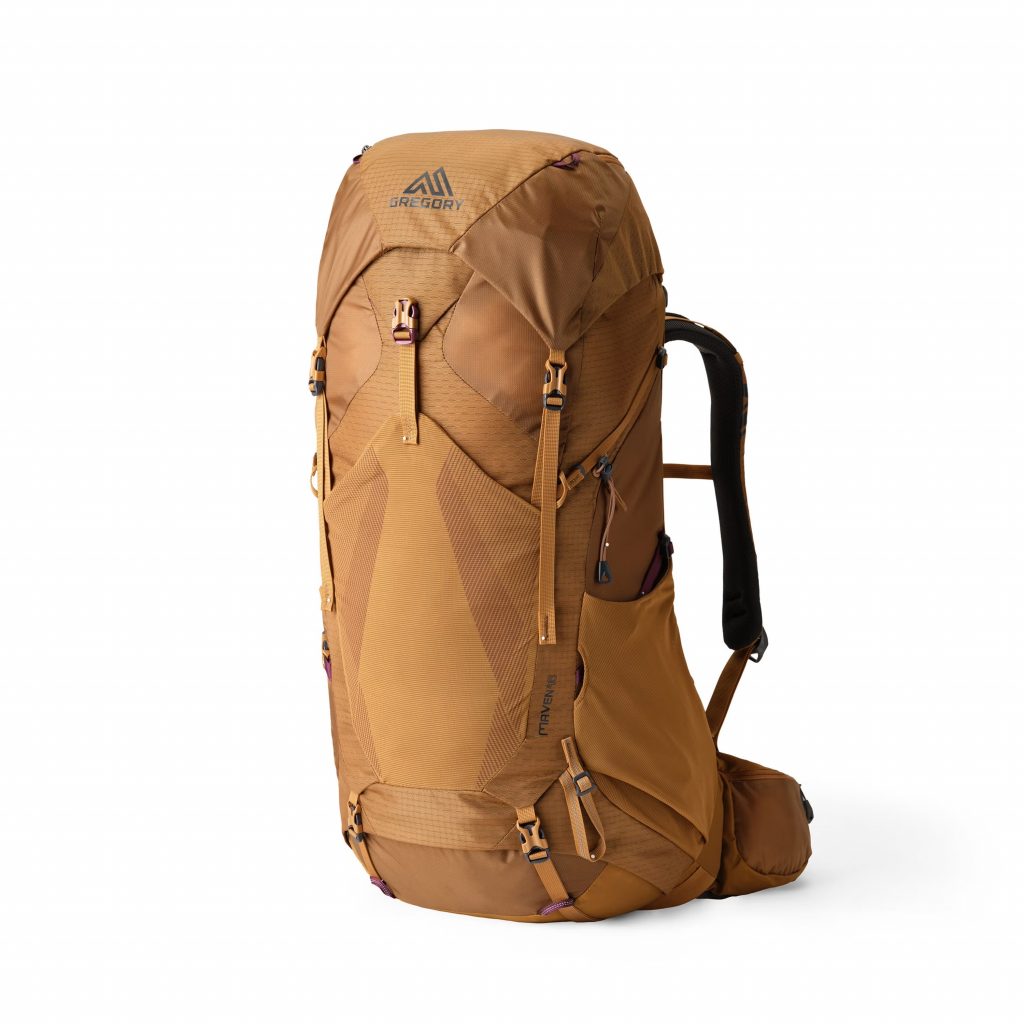
Weight: 3 lbs 4 oz / 3 lbs 2 oz
Capacity: 50L / 48L
Frame Type: Perimeter wire
Closure: Drawcord and zipper
Available In: Paragon (Men’s), Maven (Women’s)
Pros: Full-featured and well-designed for the price, great warranty
Cons: Nothing stands out
We are seriously impressed with the on-trail performance of both the Gregory Paragon 50 and Maven 48 packs. For $240, you get robust construction, a plentitude of pockets and features, super comfortable carry, and an incredible warranty. Plus, the compressibility and versatility make this a one-and-done backpacking pack.
The Paragon (designed for men) and Maven (designed for women) both feature an excellent set of pockets and are surprisingly lightweight for a full-featured pack. Stretchy exterior pockets, secure zippered pockets on the waistbelt, and a cavernous interior make packing easy for both weekend trips and longer. The 3D comfort belt and AirCushion backpanel combine for one of the better suspension systems we’ve tested, and even loaded up to nearly 30 pounds, this pack was exceedingly comfortable. Our only hesitation with this pack is that nothing stands out. But if you need a reliable and quite affordable pack that’ll last you years, the Gregory Paragon and Maven are awesome options.
Check Paragon Price on REI Check Maven Price on REI
Hyperlite Unbound 55 ($399)
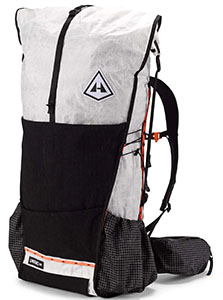 Weight: 1 lb 14 oz
Weight: 1 lb 14 oz
Capacity: 55L inside, 9L outside
Frame Type: Single aluminum stay
Closure: Roll-top
Available In: Unisex
Pros: Large outer pocket fits extra layers with no problem
Cons: Lack of storage options for small items
Hyperlite Mountain Gear’s Unbound 55 backpacking backpack punches far above its sub-2-pound weight. The large outer pocket adds an extra 9 liters of usable space, making everything from extra layers to even your sleeping bag accessible for quick outer stashing. The materials are solid and, despite being light, held up through thick and thin, with frequent packing and unpacking.
Perhaps the best testament to the Hyperlite’s quality was seeing it in action at 19,000 feet on Mount Logan in the Yukon. Although it wasn’t this specific model, it was enough to know that Hyperlite makes gear that can hold up in the worst possible conditions. The Unbound 55 we tested provided a great weatherproof main pocket that is easily expandable or compressible thanks to the large roll-top, and the no-nonsense design helps those who are counting grams. As with other ultralight packs, the lack of options to store small items is a bummer for gearheads like ourselves, but not a deal-breaker. And for such a lightweight frame, the Unbound is comfortable and carried the test load well for the full duration of our hikes.
REI Co-Op Traverse 60 ($249)
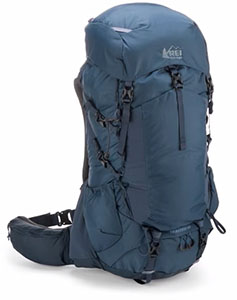 Weight: 4 lbs 4 oz
Weight: 4 lbs 4 oz
Capacity: 60L
Frame Type: Aluminum
Closure: Cinch top
Available In: Men’s, Women’s
Pros: Great value
Cons: Fabric attracts mud/dust
We’ve had great luck with REI packs, and their latest backpacking backpacks represent a fantastic value. The Traverse series has gone through several versions in its time, always becoming slightly more refined, lighter, and more comfortable. The current iteration is a workhorse pack for a solid price.
In some ways, the function takes a bit too much spotlight, and the many straps felt overkill. But we can appreciate the people who make use of all of them. You’ll be happy to have so many different ways to attach whatever you please to this backpack. External attachments do speed up packing and access, however, this also makes the pack (and your externally attached gear) more prone to snagging.
The Traverse includes a rain fly for trips where you need a bit more protection from the elements, something we appreciated while testing in the temperate rainforests of the Coast Mountains in British Columbia. One drawback: Without the cover, we found the pack’s material to attract dust and mud fairly easily. Some people might like that trail-used look, but we prefer something that cleans up a bit more easily. Overall, the pack performed admirably and comes in at a more affordable price than many of our top picks.
Check Men's Price on REICheck Women's Price on REI
Kelty Glendale 65 ($240)
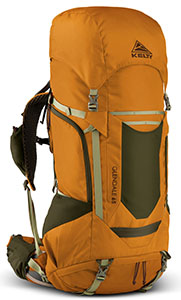 Weight: 4 lbs 12 oz
Weight: 4 lbs 12 oz
Capacity: 65L
Frame Type: Perimeter frame + shoulder stay
Closure: Cinch top
Available In: Men’s, Women’s
Pros: Great value, innovative design elements
Cons: Straps have a lot of tail when cinched
Kelty has been around since 1952 and was an early innovator of external frame backpacks for backpacking use. With a ton of experience in the space, the brand has helped millions of people around the world enjoy the outdoors without breaking the bank. Its latest backpack, the Glendale, is the culmination of over 70 years of innovation, designed to deliver a comfortable, well-made, and versatile backpack at a more approachable price.
We love the internal stash pocket in the top to keep valuables accessible, the external stash pocket for tossing layers when it gets hot, and the all-around simplicity of the design where nothing felt excessive or out of place. Our only caveat is that the straps are a bit long and flapped around in the wind after cinching down. This makes them more susceptible to snags, so a rubber band or something to secure the excess straps would help.
Some may look at a lower-priced model and think the quality isn’t there, but Kelty backs up their gear with a lifetime warranty. That’s a welcome bonus to those who like to give their gear the run-around — we sure do. And through all the testing we never found a reason to file a warranty claim, but it’s nice to know it’s there if you need it.
Check Price on Kelty Check Women's Price on Kelty
The North Face Trail Lite 65 ($240)
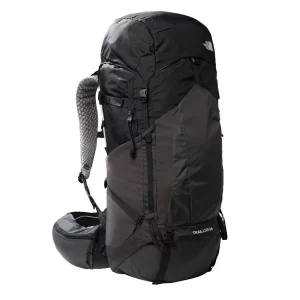 Weight: 3 lbs 15 oz
Weight: 3 lbs 15 oz
Capacity: 65L
Frame Type: Aluminum perimeter + plastic backplate
Closure: Cinch top
Available In: Men’s, Women’s
Pros: Well-designed, lifetime warranty
Cons: Outer pocket isn’t too protected from the elements
The North Face makes gear for all kinds of activity levels, from casual day hikes to expeditions in the Himalayas. The Trail Lite backpacking backpack is somewhere between those extremes, allowing for multi-day jaunts in a nice package that has been designed for both comfort and efficiency. The pack is easy to adjust and has everything you need and nothing you don’t.
The Trail Lite has a user-friendly adjustment setup to really dial in a custom fit specific to your individual body shape. It’s especially beneficial for people who might share a backpacking backpack and need to change the settings quickly and easily. And on top of all that, it’s just a comfortable pack to wear that always felt secure, regardless of mileage. Speaking of, the pack itself is designed to go on and on as The North Face has a lifetime warranty to back it up should something go wrong. While this pack didn’t stand out in any one category, it is an excellent choice, especially considering it is less than $250.
Backpacking Backpacks Comparison Table
| Name | Price | Weight | Capacity | Frame Type | Closure | Available In |
| Osprey Atmos AG 65 / Aura AG 65 | $340 | 4 lbs 10 oz | 65L | Aluminum | Roll + cinch | Men’s, Women’s |
| REI Co-op Flash 55 Pack | $199 | 2 lbs 13 oz | 55L | Steel | Roll + cinch | Men’s, Women’s |
| Osprey Aether Pro 75 / Ariel Pro 75 | $400 | 5 lbs | 75L | Peripheral hoop | Roll +cinch | Men’s, Women’s |
| Mystery Ranch Radix 57 | $299 | 3 lbs 13 oz | 57L | Aluminum | Cinch top | Men’s, Women’s |
| Zpacks Arc Haul Ultra 60L | $399 | 1 lb 6 oz | 47L inside, 8L center, 2.5L sides | Tension strap | Roll-top | Unisex |
| Gossamer Gear Skala 38 | $225 | 1 lb 4.4 oz | 38L | Frameless | Roll-top | Unisex |
| Fjallraven Kajka 65 | $375 | 6 lbs 15 oz | 65L | Wood | Cinch top | Unisex |
| Outdoor Vitals CS40 Ultra | $375 | 1 lb 11 oz | 53L | Carbon fiber stays | Roll-top | Unisex |
| Gregory Paragon 50 / Maven 48 packs | $240 | 3 lbs 4 oz | 50L/48L | Perimeter wire | Cinch top | Men’s, Women’s |
| Hyperlite Unbound 55 | $399 | 1 lb 14 oz | 55L inside, 9L outside | Single aluminum stay | Roll-top | Unisex |
| REI Co-Op Traverse 60 | $249 | 4 lbs 4 oz | 60L | Aluminum | Cinch top | Men’s, Women’s |
| Kelty Glendale 65 | $240 | 4 lbs 12 oz | 65L | Perimeter frame + shoulder stay | Cinch top | Men’s, Women’s |
| The North Face Trail Lite 65 | $240 | 3 lbs 15 oz | 65L | Aluminum perimeter +plastic backplate | Cinch top | Men’s, Women’s |

The backpacks that made the cut. Photo: Steve Andrews//The Inertia
How We Tested Backpacking Backpacks
With backpacks coming in a plethora of shapes and styles, it’s easy to get lost (so to speak) considering every single pack on the market. Instead, we narrowed our list down a bit so that we could test a few categories really well. We wanted to make sure that we could properly test each backpack thoroughly enough to give an educated opinion on how it works over considerable mileage, which is really all that matters when it comes down to it.
Lead testers Steve Andrews and Nathan Lemin set up a simple kit to load into each of these packs, keeping them all the same to help give a degree of consistency when testing them against one another. Since everybody has different needs and wants on a backpacking trip, we tried to make the kit as generic as possible, where people could add or subtract items as needed to dial in their comfort level.
We also set up the items to be fairly average in weight and size. That way, people can either go ultralight if they want to shave ounces or add in the luxury if they can’t leave home without their electric toothbrush or coffee grinder. Here’s what we included:

Some of the gear you might need for a walk into the wilderness. Photo: Steve Andrews//The Inertia
As you can see, there is plenty to work with here to include other items such as first aid equipment, a beefier camera, an ebook reader (or a traditional book/journal), extra clothing, snacks, or extra water bottles. We knew that there was some room for customization, but didn’t want to get too locked in on personal preference, only sticking to essentials. Sure, the GoPro camera and charging unit probably aren’t in everyone’s kit, but as media folks, we are typically packing at least some camera equipment.

Our lead tester, Steve Andrews, cruises through the cedar forests in the Coast Mountains. Photo: Lindsay Gough//The Inertia
Testing Conditions
Originally, we took these backpacks out on the trail in some of the world’s premier backpacking locations: Idaho’s Sawtooth Mountains, coastal California, the PCT, as well as the Coast Mountains of British Columbia. In subsequent backpacking seasons, we tested packs along sections of the Arizona Trail, in the Channel Islands National Park, and at Crater Lake National Park. Each zone is home to some beautiful mountain scenery, but also to some incredible trails to take you deep into the backcountry. Don’t tell too many people, though, as part of the appeal is how easily you can get away from it all.
Both zones offer ample opportunity to put in a lot of miles on both dirt and rock in a short amount of time. It helped us to test these backpacks in their natural habitat, getting a proper feel for what they are made of, without rushing too much to allow for them to break in and test both uphill and downhill, on-trail and off, and in both wet and dry climates. Being able to really see what capabilities each backpacking backpack has involves a lot of packing and unpacking, and finding the sweet spot for optimum balance and comfort for logging big days on the trails.

We went into the wild to test how these packs did both on and off-trail. Photo: Lindsay Gough//The Inertia
Backpacking Backpacks Buyer’s Guide
Read through our buyer’s guide for the best backpacking backpacks to help you decide what features you need and what packs are best suited to you.
Key Features to Look For in a Backpacking Pack
As demonstrated above, there are a lot of different options for backpacking backpacks, from simple and lightweight to technical and durable. So, narrowing down the perfect backpack for your style might seem like an overwhelming task. Here are a few criteria to help you dial in what to look for when choosing the best backpack for your needs:
Capacity
Measured in liters, the capacity you need depends on the length of your trip and how much gear you plan to carry. A weekend trip might require just a 30-50-liter pack, while a week-long adventure may demand 50-70 liters or more.
Fit
A good fit is crucial for comfort. Look for adjustable shoulder straps, a hip belt, and a torso length that matches your body. Many brands offer gender-specific designs for a better fit. When in doubt, read customer reviews for other user experiences or try packs on. The Osprey Atmos AG 65 / Aura AG 65 and the Gregory Paragon 50 / Maven 48 packs had top-rated fit in our tests.

Two of our top picks, the Osprey Atmos AG 65 and the REI Co-op Flash 55 Pack, served our testers well on the Channel Islands. Photo: Nathan Lemin//The Inertia
Weight
The lighter the backpacking backpack, the less strain on your body. However, don’t sacrifice durability for weight. Sometimes lighter packs offer less supportive load distribution. Consider a balance that suits your physical capabilities and the demands of your trips. The UL Zpacks Arc Haul Ultra 60L and the Gossamer Gear Skala 38 were light, but sacrificed some comfort.
Material
The fabric found in backpacking backpacks greatly impacts its durability, weight, and water resistance. Here are some common backpack fabrics:
Cordura: Known for its durability and resistance to abrasions, tears, and scuffs. It’s a bit heavier but excellent for rugged use.
Dyneema Composite Fabric (DCF): Formerly known as Cuben Fiber, DCF is ultralight, waterproof, and strong but can be prone to punctures and is expensive.
Ultra-High-Molecular-Weight Polyethylene (UHMWPE): Often found in high-end backpacks, it’s extremely durable and abrasion-resistant but also expensive.
Ripstop Nylon: Lightweight and durable, with a reinforced grid pattern that resists tears. It’s a common choice for lightweight backpacks.
Polyester: Often used in budget-friendly backpacks, it’s less durable than nylon but more resistant to UV degradation.
Ventilation
A backpack with good back ventilation (in the form of back vents or breathable materials) can prevent sweat buildup and increase comfort during long hikes.
Accessibility
Multiple compartments and external pockets can help you organize and easily access your gear. Look for features like a sleeping bag compartment, hydration sleeve, and tool attachments.
Load Support (Suspension/Frame Supports)
The suspension system of a backpack helps distribute the load evenly, reducing strain on your shoulders and back. Common types of internal frames include:
Stays: These are often aluminum rods that provide structure and support, helping transfer some of the shoulder load to the hip belt.
Pads: Foam padding can add comfort and support, especially in the back panel and shoulder straps.
Frame Sheets: These are rigid panels that add structure and support to the backpack, often made of plastic or composite materials.
A good suspension system can make a significant difference in comfort, especially for heavier loads.

The daisy chain gear loops on the ZPacks Arc Haul shoulder straps make it easy to keep a multitool in close reach. Photo: Lindsay Gough//The Inertia
Determining Your Backpacking Backpack Needs
To find the best backpack for your needs, consider the following:
Trip Length: Choose a capacity that matches the duration of your trip or most frequent usage.
Personal Comfort: Prioritize a good fit and adequate ventilation.
Activity Type: Look for features that cater to your specific activities, such as climbing or snow sports.
Budget: Balance quality and cost to find a backpack that offers good value for your investment.

The Osprey Atmos AG 65 is an incredibly comfortable and well-thought-out backpacking backpack. The high-end, sustainable materials and spacious capacity led us to pick it as our top pick. While it is pricey, no other pack in our list could boast the same combination of performance and quality.
Packing Your Backpacking Backpack
Packing your backpack efficiently can make a significant difference in your comfort and mobility on the trail. Here are some tips:
Bottom Layer: Pack your sleeping bag and other lightweight items that you won’t need until you set up camp.
Middle Layer: Place heavier items like your tent, stove, and food close to your back to keep the center of gravity near your spine.
Top Layer: Pack lighter items and essentials that you might need quick access to, such as a rain jacket or first aid kit.
Outer Pockets: Use these for items you need to access frequently, like water bottles, snacks, and maps.
Compression Straps: Use these to cinch down your load and prevent items from shifting.

Always load your sleeping bag or quilt into your backpacking pack first. Photo: Nathan Lemin//The Inertia
Utilizing Features of Backpacking Backpacks
Here are some tips on how to make the most of various backpack features:
Cinch-Straps: These help stabilize your load and can be used to attach items like trekking poles or a sleeping pad externally.
Roll-Top: A roll-top closure can provide extra weather protection and allow you to adjust the volume of your pack.
Gear-Loops: Use these to attach equipment like ice axes or carabiners.
Hip-Straps: A well-fitted hip belt can transfer much of the weight from your shoulders to your hips, improving comfort.
Outer Pockets: Ideal for storing items you need quick access to, like water bottles or a rain cover.
Rain-Covers: These are essential for keeping your gear dry in wet conditions. Many backpacks come with a built-in or included rain cover, or you can purchase one separately.

The Outdoor Vitals CS40 Ultra was at home exploring the Idaho Wilderness. Photo: Steve Andrews//The Inertia
Return to Comparison Table | Return to Top Picks
Editor’s Note: Going backpacking? Check out our other backpacking gear guides here. For other gear we cover, click here. For the most recent gear coverage on The Inertia, click here.




